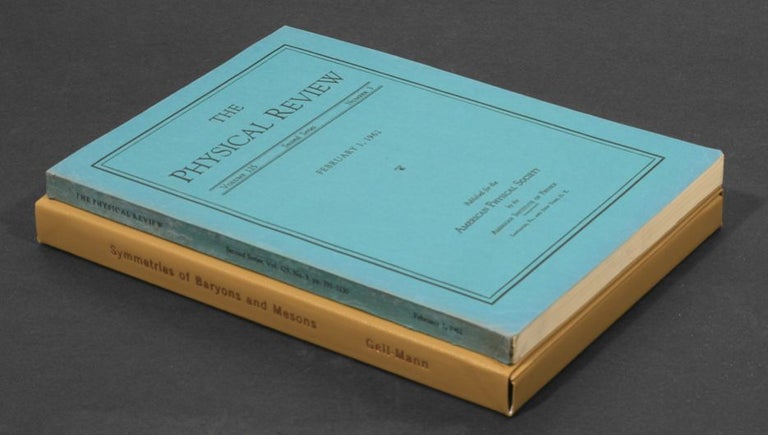Symmetries of Baryons and Mesons
“Professor Gell-Mann. You have given fundamental contributions to our knowledge of mesons and baryons and their interactions. You have developed new algebraic methods which have led to a far-reaching classification of these particles according to their symmetry properties. The methods introduced by you are among the most powerful tools for further research in particle physics..." -Nobel Prize Presentation Speech
FIRST EDITION of Murray Gell-Mann's Nobel-Prize winning work on the discovery of the "Eightfold Way"
"Gell-Mann, as naturalist, collector, and categorizer, was well primed to interpret the exploding particle universe of the 1960s. New technology in the accelerators- liquid hydrogen bubble chambers and computers for automating the analysis of collision tracks- seemed to have spilled open a bulky canvas bag from which nearly a hundred distinct particles had now tumbled forth. Gell-Mann and, independently, an Israeli theorist, Yuval Ne'eman, found a way in 1961 to organize the various symmetries of spins and strangeness into a single scheme. It was a group, in the mathematicians' sense of the word, known as SU(3), though Gell-Mann quickly and puckishly dubbed it the Eightfold Way. It was like an intricate translucent object which, when held to the light, would reveal families of eight or ten or possibly twenty-seven particles- and they would be different, though overlapping, families, depending on which way one chose to view it. The Eightfold Way was a new periodic table- the previous century's triumph in classifying and thus exposing the hidden regularities in a similar number of disparate 'elements.' But it was also a more dynamic object. The operations of group theory were like special shuffles of a deck of cards or the twists of a Rubik's cube.
"Much of SU(3)'s power came from the way it embodied a concept increasingly central to the high-energy theorist's way of working: the concept of inexact symmetry, almost symmetry, near symmetry, or- the term that won out- broken symmetry. The particle world was full of near misses in its symmetries, a dangerous problem, since it seemed to permit an ad hoc escape route whenever an expected relationship failed to match. Broken symmetry implied a process, a change in status... Many of the broken symmetries of particle physics came to seem like choices the universe made when it condensed from a hot chaos into cooler matter, spiked as it is with so many hard-edged, asymmetrical contingencies.
"Once again Gell-Mann trusted his scheme enough to predict, as a consequence of broken symmetry, a specific hitherto-unseen particle. This, the omega minus, duly turned up in 1964- a thirty-three-experimenter team had to canvass more than one million feet of photographs- and Gell-Mann's Nobel Prize followed five years later" (James Gleick, Genius).
Particle Physics, One Hundred Years of Discoveries: "Introduction of the SU(3) singlet-octet structure of the known mesons and octet-decuplet structure for the baryons. Prediction of the Ω- hyperon. Nobel prize to M. Gell-Mann awarded in 1969 'for his contributions and discoveries concerning the classification of elementary particles and their reactions'." NOTE: Gell-Mann first introduced the concept of the Eightfold Way in a 1961 Cal. Inst. Tech Report (CTSL-20) before developing his ideas more fully in his famous paper in The Physical Review.
In: The Physical Review, Vol 125, pp. 1067-1084. Lancaster, PA and New York, NY: American Institute of Physics, 1962. Quarto, original printed wrappers; custom box. A little spotting to spine, otherwise fine.
Price: $2,200 .


